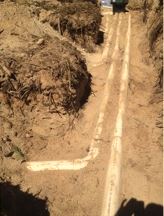Infiltrator Installations
I’m not a big fan of infiltrators, but they are called for in certain situations. If your native soils are relatively sandy and without a lot of big rock and you live remotely where getting clean drain rock is extremely expensive or impossible (like say a boat access place,) then Infiltrator Chambers are a cost effective system design solution.
My lack of enthusiasm for infiltrators comes from seeing premature failures of infiltrator systems that simply doesn’t happen with traditional drain rock seepage beds and trenches. Infiltrators can get clogged by burrowing rodents. They are also susceptible to getting filled with silt in silty soils with poor drainage. I have seen these things happen firsthand. Also, I believe the small amount of treatment and aeration that effluent receives trickling through 6″ plus of clean drain rock under gravity lateral pipes improves the effluent/soil interface – versus direct application like with infiltrator chambers.
Here is a video link to a sales pitch on them by the company that manufactures them: Infiltrator Chamber Video Link
Krestova, November 2015
This entire small system was completed in one day (9.5 hours!)
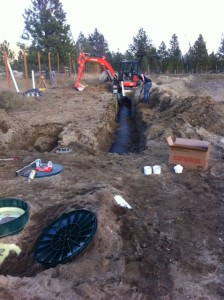
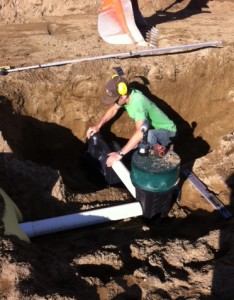
Vallican, October 2015
In the first photo you can see three (of four) observation ports at the end of each of the infiltrator rows. These will be cut off at ground level once final grading is finished. On the far left you can also see a vent pipe used in some designs to ensure adequate oxygenation of the system.
The second photo is of the completed installation prior to spreading a layer of topsoil on top of it. The four red arrows point to the observation ports. The blue arrows point to oxygenation ports that the planner has specified.
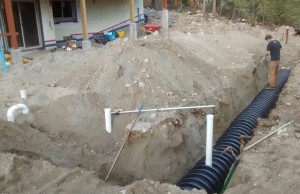
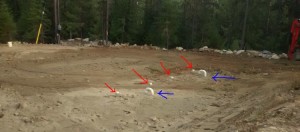
Nelway, September 2015
A final row of infiltrators waiting to be installed.
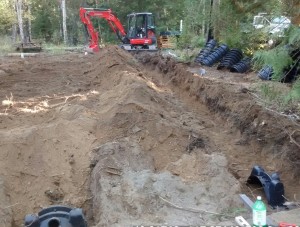
Castlegar, July 2015
The soil on this project had a lot of bigger rocks in it. That can make it slow going back-filling over the infiltrators ensuring they don’t get crushed. This photo shows well-bedded and tamped 4″ sewer pipe leading from the distribution box to the head of each infiltrator rows. Taking the time to bed and tamp well is a critical component of a good installation.
